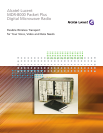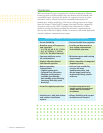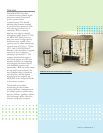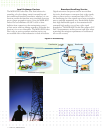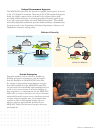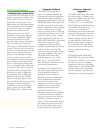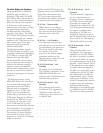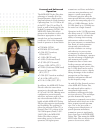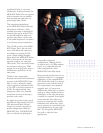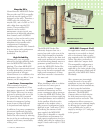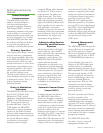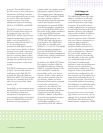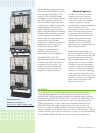
9Alcatel-Lucent | MDR-8000 Packet Plus
F
lexible Ethernet Options
Having established its reliability,
scalability, and versatility in
delivering TDM traffic, the MDR-
8000 Packet Plus is also poised for
the next wave of network migration.
With the industry-wide migration
to IP data networks, carriers are
requiring innovative ways to bridge
the gaps between their legacy
networks and the packet-based
networks of the future. The MDR-
8000 Packet Plus Ethernet interface
utilizes the same RF and common
modules as the TDM versions of the
radio, operating in all the same
frequency bands and virtually
identical bandwidths.
The Ethernet interface supports
10/100/1000 Base-T transport, with
a possible combined data throughput
of 300 Mb/s in a single shelf. The
Ethernet I/O card offers RJ45
electrical and SFP optical inputs,
both of which are auto-sensing. In
addition, the Ethernet interface
supports a variety of bandwidth
choices which enables users to tailor
the radio to meet facility and data
transport requirements of today and
tomorrow.
The Ethernet interface of the
MDR-8000 Packet Plus also allows
users to gracefully migrate their
network services from TDM to
Ethernet with no equipment
changeout. Up to 32 DS1s (48
Mb/s) can be individually and
dynamically provisioned to carry
TDM traffic alongside the Ethernet
bandwidth. As TDM services get
converted to IP over time, each
of the TDM-based DS1s can be
deprovisioned individually, allowing
that bandwidth to be recaptured as
part of the Ethernet bandwidth.
Provisioning (or deprovisioning)
can be done in-service, with no
disruption to other DS1 or Ethernet
traffic on the radio.
U
nlike standard TDM radios, the
Ethernet version of the MDR-8000
Packet Plus offers input/output
(I/O) provisioning options and
operating modes uniquely developed
to support packet data transport:
■ A Only – Nonstandby
While the most cost-effective
method of transporting Ethernet,
this operating mode provides no
Ethernet port or radio link
protection.
■ A Only – Hot Standby
This operating mode provides
radio link protection, but does not
provide Ethernet port protection.
This mode would be used when
the operator desires link
protection, but cannot support
redundant interfaces in the
Ethernet device connected to the
MDR-8000 Packet Plus.
■ A & B Switched – Hot
Standby
By making use of the Ethernet
Port Switching capabilities of the
MDR-8000 Packet Plus, this
mode provides both Ethernet port
and radio link protection.
■ A & B Summed – Hot
Standby
This operating mode utilizes
the Ethernet Port Aggregation
capabilities of the radio and
combines two data sources over
a single RF link.
■
A & B Separate – Dual
Channel
The dual channel configuration
uses the same hardware as a
frequency diversity configuration
in a TDM version of the radio.
It provides two separate RF
channels from a single shelf. The
A & B Separate operating mode
can support a combined data
throughput of 300 Mb/s in a
single shelf. However, if one of
the RF channels failed, half of the
data would be lost, although the
DS1s would still be protected.
■ A & B Summed – Dual
Channel
This mode also makes use of
the Ethernet Port Aggregation
capabilities of the radio. When
the radio is operating in normal
mode without failures, it operates
in a similar manner as the A & B
Separate – Dual Channel. The A
& B Summed mode also supports
a combined data throughput of
300 Mb/s in a single shelf. In this
configuration, the full 300 Mb/s
radio bandwidth is available to
either Ethernet input to handle
traffic bursts. In addition, if one
of the RF channels fails, the data
is summed onto the remaining
working channel and the
throughput of the shelf falls back
to a combined total of 150 Mb/s.
The DS1s are always protected.



